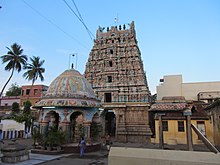Chakrapani Temple
| Chakrapani Temple | |
|---|---|
 Chakrapani Temple, Kumbakonam | |
| Religion | |
| Affiliation | Hinduism |
| District | Thanjavur |
| Deity | Chakrapani(Vishnu ) Seetha Devi (goddess) |
| Location | |
| Location | Kumbakonam |
| State | Tamil Nadu |
| Country | India |
Chakrapani Temple is a
Legend

As per Hindu legend, Chakra (also called Sudarshana), the discus, is the most powerful weapon of god Vishnu. He once sent his weapon to nether world to kill king Jalandasura. The weapon is believed to have come out of the nether world through river Kaveri. God Brahma, who was taking bath in the river, got impressed and installed the image of Sudarshana in the place where the temple is now located. Surya, the Sun god, who was glowing in brilliance, had his brightness diminished by the effulgent Sudarshana. Surya worshipped Sudarshana and pleased by his devotion, Sudarshana restored all the powers of Surya.[3] Vishnu attained the name Chakrapani from then on.[4] Surya wanted the town to be named after him and pleased by his devotion, Chakrapani named the city as Bhaskara Kshetra.[3] It is believed that Surya worshiped Chakrathazhwar during Masi Magam and every year Masi Magam festival is celebrated during the day, commemorating the event. The temple car is drawn around the streets of the temple during the day.[5]
As per another legend, during the great deluge, the pot of nectar came down swirling. The pot of nectar fell down into different pieces as Shiva shot his arrow at the pot. The nectar is believed to have relieved lives in the planet. As per Sarma Sastrigal, the various places where the nectar spilled are
History
The temple is one of the prominent Vishnu temples in
Architecture
The temple has granite walls enclosing all the shrines and pierced by a five-tiered rajagopuram, the gateway tower. The temple is noted for its exquisite pillars. The presiding deity, Chakrapani is sported with eight arms, each having a weapon and is housed in the central shrine in an elevated structure. Chakrapani is sported with a third eye on his forehead. The Eastern and Western entrances of this temple are known as "Thatchinaya Vayil" and "Utharavana Vayil" respectively and outer Prakara of this temple is made in the form of balcony. There is a bronze image of king Serfoji II worshipping the lord as he is said to have been cured an illness by the grace of this God. A panchamukha (five-faced) Hanuman is erected in the prakaram (outer precincts of the temple).[10] Agampara Vinayakar, Panchamuga Aancheneyar and Vijayavalli are the important idols located in this temple.
Festivals and religious practices
The temple is counted as one of the temples built on the banks of
Five Vishnu temples are connected with Mahamaham festival which happens once in 12 years in Kumbakonam.[12] They are:
- Sarangapani Temple,
- Chakrapani Temple,
- Ramaswamy Temple,
- Rajagopalaswamy Temple, and
- Varahaperumal Temple.
This temple, one among them, is situated in the north of Big Street.
The Mahasamprokshanam also known as Kumbabishegam of the temple was held on 8 November 2015.[13]
See also
- Mahamaham tank, Kumbakonam
- Hindu temples of Kumbakonam
Notes
- ^ Ayyar 1991, p. 325
- ^ South Indian Railway Company 1926, p. 57
- ^ a b Madhavan 2007, pp. 98-100
- ^ Gopal, Madan (1990). K.S. Gautam (ed.). India through the ages. Publication Division, Ministry of Information and Broadcasting, Government of India. p. 81.
- ^ S., Prabhu (18 February 2016). "The 12-year wait for a dip". The Hindu. Retrieved 2 October 2016.
- ^ "Celestial congregation". The Hindu. 18 February 2016. Retrieved 2 October 2016.
- ISBN 978-93-83440-34-4.
- ISBN 978-81-7907-053-6.
- ^ Diaspora of the gods: modern Hindu temples in an urban middle-class world .P.246. Joanne Punzo Waghorne
- ^ Tourist Guide to Tamil Nadu. P.70
- ISBN 9781684666041.
- ^ Mahamaham Festival 2004 (in Tamil), Hindu Religious and Charitable Endowments Administration Department, Government of Tamil Nadu, 2004
- ^ "Kumbabhishekam performed". The Hindu. 9 November 2015. Retrieved 10 November 2015.
References
- Madhavan, Chithra (2007). Vishnu Temples of South India Volume 1 (Tamil Nadu). Chithra Madhavan. ISBN 978-81-908445-0-5.
- Illustrated Guide to the South Indian Railway (Incorporated in England): Including the Tanjore District Board, Pondicherry, Peralam-Karaikkal, Travancore State, Cochin State, Coimbatore District Board, Tinnevelly-Tiruchendur, and the Nilgiri Railways. Madras: South Indian Railway Company. 1926. ISBN 9788120618893.
- Ayyar, P. V. Jagadisa (1991). South Indian shrines: illustrated. New Delhi: Asian Educational Services. ISBN 81-206-0151-3.








